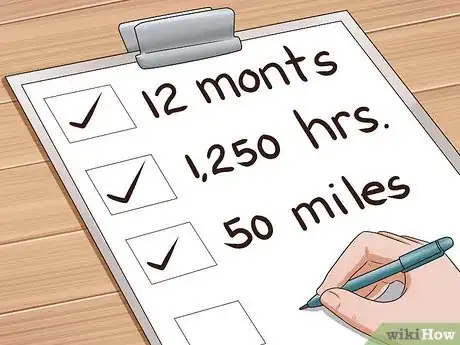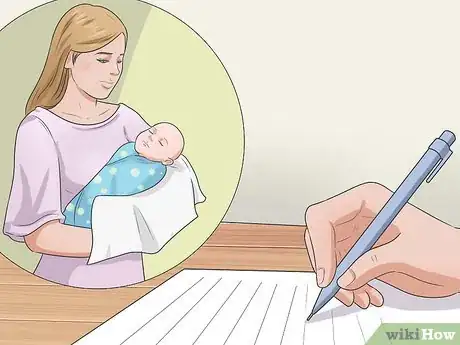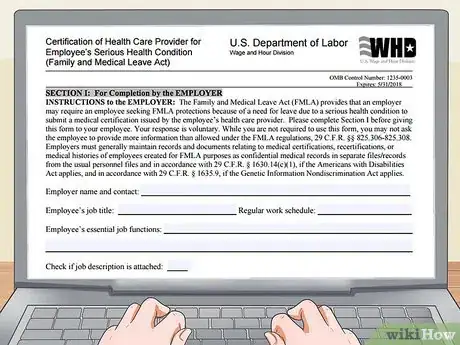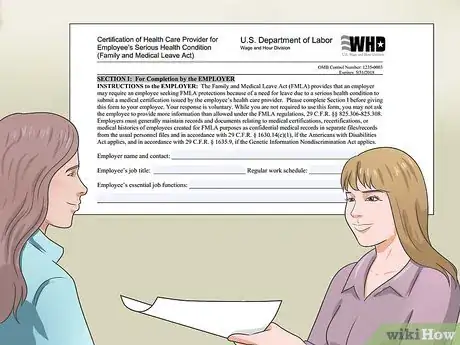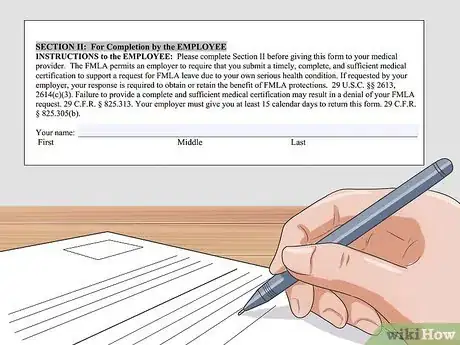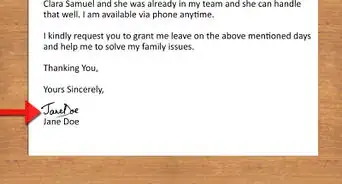This article was co-authored by Clinton M. Sandvick, JD, PhD. Clinton M. Sandvick worked as a civil litigator in California for over 7 years. He received his JD from the University of Wisconsin-Madison in 1998 and his PhD in American History from the University of Oregon in 2013.
This article has been viewed 369,867 times.
The Family and Medical Leave Act (FMLA) is a program regulated by the United States Department of Labor (DOL) that allows employees of employers covered by the Act to take an unpaid, medical leave of absence from their jobs. You may be approved for FMLA if you have just given birth, have a serious health condition, or are caring for a family member with a serious health condition. Filling out the form correctly will help ensure that your request for leave is processed in a timely manner.
Steps
Determining Your FMLA Eligibility
-
1Determine how much you’ve worked for your current employer. In order to qualify for FMLA, an employee must have met certain requirements. [1] The employee must:
- The employee must have worked for the employer for at least 12 months. This 12 months does not have to be consecutive, but the employer doesn’t have to count the time that you weren’t working towards your 12 months. For example, if an employee worked for an employer for 3 months, then took a 4 month break and returned to work for 6 months, the employer will only count the employee as having worked for them for 9 months. In this case, the employee will not qualify for FMLA.
- The employee must have worked at least 1,250 hours for the employer in the 12 months immediately preceding the leave
- The employee must work at a location with 50 or more employees within a 75-mile radius.
- If an employee takes leave to serve in the U.S. military, the military leave time counts towards the employment hours required for FMLA.
-
2Apply for leave to take care of a child. If you have a newborn or you have just adopted a child, you may be eligible to take family leave. Employers must grant leave to eligible employees in the following circumstances:[2]
- To bond with a newborn child
- To bond with a newly adopted child
- To bond with a child placed with the employee for foster care,
- An employee may also take FMLA leave because of a difficult pregnancy.
Advertisement -
3Apply for leave to take care of a family member with a health problem. Employees can take FMLA leave to care for a sick family member. [3] The employer may ask the employees to provide certification of the illness from a health care provider.
- The only family members that count for purposes of FMLA are the employee’s spouse, parents, and children.
-
4Apply for leave due to your own health problems. If you have a health issue that is interfering with your work, you may be able to take leave from your job while you recover. To take FMLA leave for your own health problem, you must:
- Be suffering from a serious health condition, and
- Be unable to perform one or more of the essential duties of his or her job.
- The employer can ask the employee to provide certification of the illness from a health care provider.
-
5Apply for leave to cover a qualifying exigency. Employees may take FMLA leave while the employee’s spouse, child or parent is on active duty status. This is a “qualifying exigent situation” if the employee encounters one of the following situations:
- Short-notice deployment: Leave is available if a family member is notified of the call to active duty within 7 days of the date of deployment.
- Military events and related activities: Leave may be taken to attend any event sponsored by the military, including family support and assistance programs.
- Childcare and school activities: The employee may take leave to arrange alternative childcare if the active duty of the family member requires a change.
- Financial and legal arrangements: Leave is available to deal with financial or legal matters necessary to address the active duty family member’s absence.
- Counseling: An employee may take leave to attend counseling for oneself, the active duty family member, or any children in the family related to the active duty.
- Rest and recuperation: The employee may take leave to spend time with a family member who is on a short-term, temporary rest and recreation leave during deployment.
- Post-deployment activities: Leave may be taken to attend any post-deployment activities for up to 90 days after termination of the family member’s active duty.
Getting an FMLA Form
-
1Find FMLA forms online. Visit the Department of Labor’s FMLA website to view all FMLA forms. Make sure you get the correct form to fit your circumstance.
- If you are seeking FMLA leave because you are ill or have some other medical condition, fill out the WH-380-E form.
- If you are seeking FMLA leave because you are caring for a family member with a serious health condition, fill out the WH-380-F form.
- To take leave under the active duty “qualifying exigency” provision, fill out the WH-384 form.
-
2Contact the Department of Labor to obtain the form. If you do not have Internet access, you can call the Department of Labor (DOL) directly or visit a DOL office in your region to obtain an FMLA form.
- Call the DOL at 1-866-487-9243 between the hours of 8 a.m. and 8 p.m. Eastern Standard Time, Monday through Friday.
- The DOL can either send you an FMLA form or provide you with the address to the nearest DOL office in your region.
Completing the FMLA Form
-
1Ask your employer to complete Section 1 of the form. Your employer will be required to provide your name, job description, work schedule, and job functions on the FMLA form in Section 1.
-
2Fill out Section 2 of the form. Section 2 of the form requires you to provide your full name; including your first, middle, and last name. Some versions of the FMLA form may require additional information.
- If you are completing form WH-380-F, you will be required to provide information about the family member you are caring for during FMLA leave; such as their full name, your relationship to one another, and a description of your methods for providing care for that person.
- If you are completing the WH-384 form for a qualifying exigency, you will be required to list the exigency that you believe applies to your situation. You also need to include the date that you family member commenced active duty, and the amount of leave that you are requesting.
-
3Meet with your healthcare provider. Take your form to your healthcare provider within 15 days of receiving the form from your employer. Your healthcare provider will be required to enter facts about the medical condition. This might include information on the type of health condition, medications prescribed, how it affects your ability to work, and types of treatment required.
- Your employer will require you to return the form within this time period to be eligible for the leave.
-
4Ask your health care provider to complete Section 3 of the form. Your health-care provider will be required to provide their business contact information and details surrounding the medical condition. This might include information on the type of health condition, medications prescribed, how it affects your ability to work, and types of treatment required. He or she will also need to indicate the amount of time you will need for medical leave.
- If you are providing care for a family member and completing form WH-380-F, you will be required to take the FMLA form to your family member's health-care provider.
- Your healthcare provider is required by law to provide only factual information on this form. He or she must provide accurate dates surrounding when the health condition began, and accurate details about the treatment; such as length and frequency.
- If you are filling out the WH-384 form (qualifying exigency), this section will not apply to you.
-
5Return the completed FMLA form to your employer. Your employer will then review your completed form. If the information is complete and you have met certain conditions, your request should be approved.
- If you provide complete information and your employer denies your request for FMLA leave, you can file a complaint against your employer with the Department of Labor’s Wage and Hour Division. To begin the process of filing a complaint, visit the DOL’s website.
Warnings
- This article is for information purposes only. If you have specific questions about your circumstances, talk with your local Department of Labor office.⧼thumbs_response⧽
References
- ↑ The Essential Guide to Federal Employment Laws, Lisa Guerin & Amy DelPo, 2nd Edition (pgs. 220-221)
- ↑ The Essential Guide to Federal Employment Laws, Lisa Guerin & Amy DelPo, 2nd Edition (pgs. 222-229).
- ↑ The Essential Guide to Federal Employment Laws, Lisa Guerin & Amy DelPo, 2nd Edition (pgs. 222-229).
About This Article
To fill out a Family Medical Leave Act form, start by downloading the form that fits your circumstances from the FMLA website. Next, ask your employer to fill out Section 1, which asks for your job description, work schedule, and job functions. Then, fill out Section 2 with your full name and the reason why you’re requesting leave. Finally, meet with your healthcare provider, who will need to enter facts about your specific medical condition. To learn how to return your completed FMLA form, keep reading!
